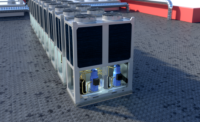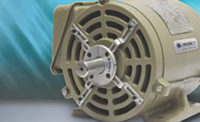Sustainability is one of the greatest priorities across all industries, and many organizations have set ambitious net-zero goals to minimize their environmental impact. This has led sustainability officers and other stakeholders to scrutinize how operations use energy and identify key opportunities for optimizing its use. For organizations with water-cooled chiller plants, this includes evaluating chiller performance and implementing new strategies that optimize power consumption.
Of all the elements in a plant room, chillers consume the most energy — up to 75% of a facility’s total energy consumption in district energy applications. It’s in an organization’s best interest to choose and integrate the most energy-efficient chiller technology possible. However, when determining chiller efficiency and selecting technology, there are misconceptions that can result in decisions that unintentionally use energy.
When evaluating chiller performance, it’s often believed that design full-load kilowatts per ton (kW/ton) represents real-world chiller efficiency. However, this metric can be misleading since most chillers in the field don’t operate at full load 100% of the time — usually it's only for a small fraction of the year. If chiller plant owners and operators only consider full loads, chillers can consume more energy than anticipated, and they lose a critical opportunity for energy savings. A more representative metric to use when evaluating chiller performance includes off-design or annual energy efficiency as well.
This real-world metric more accurately aligns specific power input to expected annual energy consumption. It also proves the effectiveness of variable-speed drive (VSD) technology at optimizing chiller energy performance in all conditions, even high-load operations.
It’s widely recognized that a chiller compressor motor equipped with a VSD is one of the most effective ways to improve annual energy efficiency levels. While VSDs use energy themselves, which can negatively impact full-load chiller performance, they still reduce overall chiller energy consumption, even at continuously high loads. When compared to plants with chillers that use constant-speed drives (CSDs), plants that use VSDs can significantly reduce operating costs and improve energy efficiency over the life of the chiller.
Understanding How VSDs Affect Performance
To ensure sufficient cooling on the most demanding days of the year, system designers will often specify chiller designs that operate at the most extreme conditions, also known as the design condition. The design condition is used to calculate the maximum instantaneous power consumption. This calculation is then used to size critical electrical components, such as circuit breakers, wires, and generators.
However, chillers run at design conditions for less than 10% of the year and off-design conditions a much greater portion of the time. This makes off-design performance more important to the overall evaluation of a chilled water system and is particularly true for process cooling applications where chillers run at high loads throughout the year, like plant rooms in data centers. In these facilities, the chilling duty does not change.
A water-cooled chiller’s instantaneous power consumption varies because of two dynamics. The first is the variation in the capacity required by the system, and the second is the amount of compression required (see Figure 2).
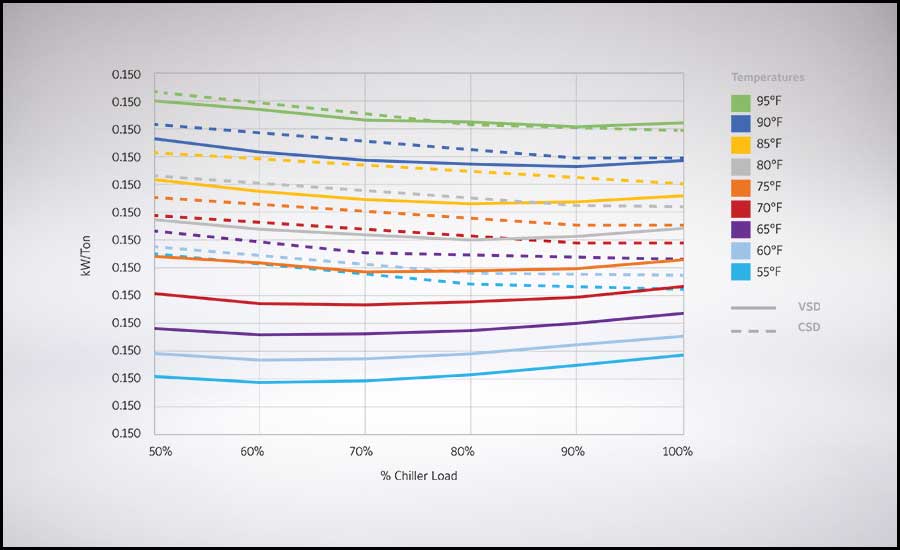
Figure 2 is a graph that presents the example of a 2,500 ton of refrigeration (TR) water-cooled centrifugal chiller. The graph isolates and compares the impact of changing loads and varying condenser water inlet temperature on a chiller’s power consumption. The solid lines represent the performance of the VSD, while the dashed lines denote the performance of the CSD.
At the design point, the full-load kW per ton is greater for the VSD chiller than the CSD chiller because of the losses from the electronics in the VSD. However, as conditions change, the improvement of the VSD chiller offsets the losses at the full load and delivers a net improvement over the life cycle of the chiller.
The key insight from the graph is that specific input power consumption is reduced as the entering condenser water temperature (ECWT) goes down. However, two important observations must also be made.
- At a given ECWT for a chiller using a CSD, the specific consumption is at its optimum, closer-to-full-load (100%) conditions. However, for a chiller using a VSD, the specific consumption improves as the load is reduced.
- Even at full-load conditions, the specific consumption of a chiller using a VSD is superior to a chiller using a CSD. This yields a net reduction in power consumption and operating costs for the chiller using a VSD.
These results prompt an interesting question: How and why does a VSD improve the performance of a chiller?
To understand how VSDs improve the performance of chillers when they are not at peak capacity and design ECWT, one must continue with the same example of a 2,500-TR centrifugal chiller (see Tables 1A and 1B). By analyzing the two dynamics that determine power consumption in a chiller, one can assign measurable units to these dynamics.
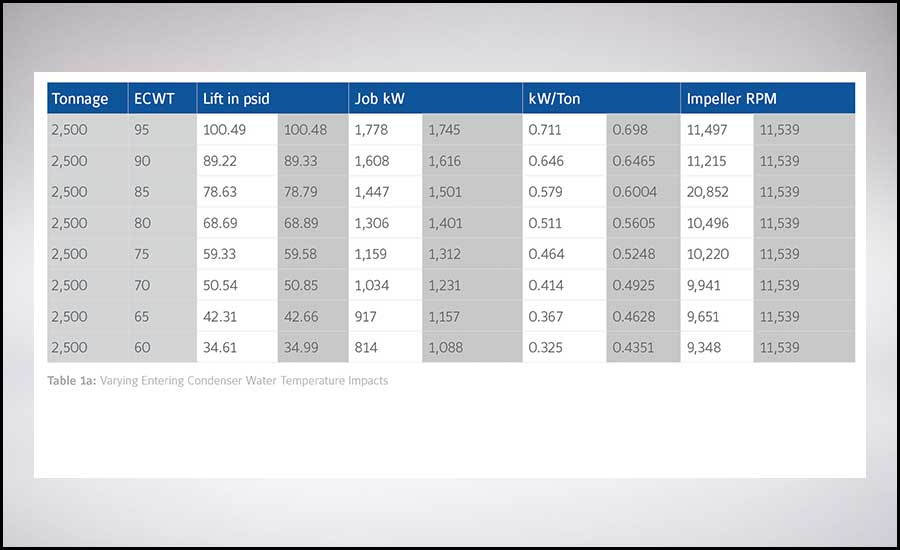
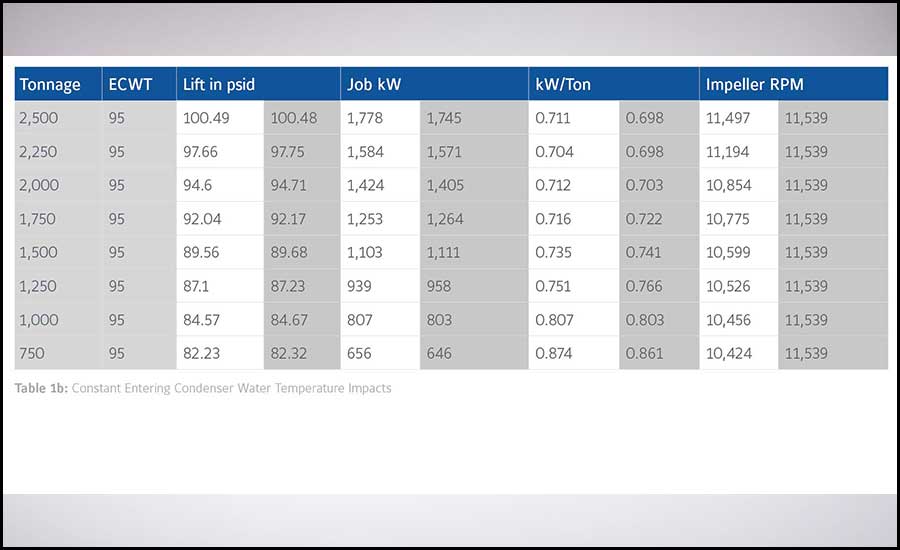
The first unit in each table (tonnage) denotes the amount of refrigerant a compressor needs to complete its work, which is directly related to a cooling load in tons (see Column 1). The second unit (ECWT) denotes the amount of work that must be done to a refrigerant, which is directly related to the differential in evaporator and condenser pressure. This is denoted as lift (Columns 3 and 4).
As the load drops from 2,500 TR to 750 TR, power consumption drops to nearly 40% of peak power. However, in both cases, the specific input power of the chiller deteriorates from 0.698 kW per ton to 0.861 kW per ton. In this case, the changing load reduces energy consumption.
When comparing chillers using CSDs with those using VSDs, the key driver for the difference in specific power input is that the VSD reduces a chiller’s load by reducing the impeller revolutions per minute (rpm) by 9% while the chiller using a CSD uses its inlet guide vanes to throttle the refrigerant flow entering the compressor. This translates to reduced efficiency in the performance of a chiller using a CSD because throttling imparts frictional losses.
This loss of efficiency relates to the performance of the inlet condenser water temperature.
When the inlet condenser water temperature drops, lift — expressed in pounds per square inch differential (psid) — is significantly reduced, even at a constant load.
In a centrifugal compressor, the compressor’s ability to develop lift depends directly on the tip speed of the impeller. However, as the demand for lift increases, the required tip speed of the impeller decreases, allowing for a reduction in motor speed.
It's important to note that, even at a constant load, the impeller rpm in a chiller using a VSD is reduced by 18%. This results in a specific power input reduction of almost 55%, which is considerably better than a chiller that uses a CSD that can only achieve a 38% reduction.
The affinity laws for centrifugal equipment prove that changes in the amount of power drawn by a compressor are proportional to the cube of the impeller’s speed. As the VSD reduces the speed of the compressor’s impeller by 18%, rotating at 82% of rpm, the power consumption would theoretically be 823%. This equates to approximately 55% of design power, which aligns closely with the observed results.
For a chiller using a CSD, impeller speed does not vary and is constant for all the load conditions. This necessitates throttling, which gives rise to the observed 17% loss in specific power consumption along with the specific power input improvements for full-load cooling from an ECWT of 85°F (29.4°C) and lower. This amounts to a significant number of operational hours for facilities with large, chilled water systems.
Establishing an Accurate Performance Metric
Reducing lift, as opposed to the load, reduces the specific power consumption of a chiller. Understanding this, a question follows: How do system designers accurately evaluate the performance of different equipment against each other?
To answer this question correctly, the performance data of the equipment must be converted into a metric that will consider real-world annual energy consumption.
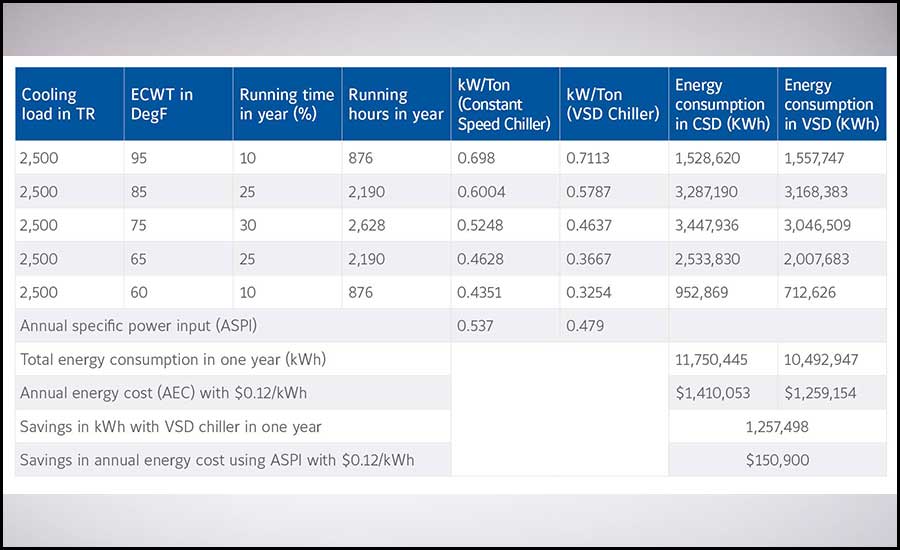
It’s very important the system designer specifies a chiller at its peak condition. This ensures the chiller delivers cooling on the hottest day in a given facility, especially when downtime or missed capacity is not an option — in district cooling plants, for example.
However, the majority of other days in a given facility allow for cooler ECWTs because of the variation in ambient temperature or, more specifically, the wet bulb temperature. Although the maximum capacity at this point is critical to system design to ensure cooling during peak demand, the specific power input does not give an accurate representation of energy consumption by the chiller as it operates throughout the year.
To effectively compare the energy consumption of two chillers that are expected to operate at nearly full loads for most of their operating hours, it’s also important to analyze the performance of the chillers at conditions of reduced ECWTs. These reflect actual weather patterns.
The annual specific power input (ASPI) is a weighted average of a chiller’s specific power input at peak power with off-design, full-load operating points where the ECWT is lower.
The ASPI of a chiller is defined as the weighted average of the full-load efficiency of that chiller for one year.
The table and equation above can be explained in the following way: 8,760 is the total number of hours in a year. The table refers to the tabulated values used in the definition of the ASPI. The weighted average of specific power input should be taken by considering the variation of ECWT throughout the year. The weighted average yields the final average efficiency number to reflect the relative importance of variation in ECWT.
Comparing Fixed- and Variable-Speed Chiller ASPI
The same example of a 2,500-TR centrifugal chiller can be used to demonstrate the variation in the full-load efficiency of a variable-speed centrifugal chiller and a constant-speed centrifugal chiller. The design conditions for the selection of these chillers are an evaporator inlet/outlet of 56°/30°F (13.3°/minus 1.1°C) and ECWT of 95°F (35°C), and the capacity requirement at these conditions is 2,500 TR.
By considering continuous full-load operations all year-round, the chiller is rated for a full load at varying ECWT. Table 3 shows the chiller operating hours for the given ECWT for climatic conditions in Dubai. The electricity tariff for Dubai is assumed to be 12 cents per kWh. Though the chiller is designed for and selected at 95°F (35°C) ECWT, the chiller will spend most hours operating with between 85° and 65°F (29.4° and 18.3°C) ECWT.
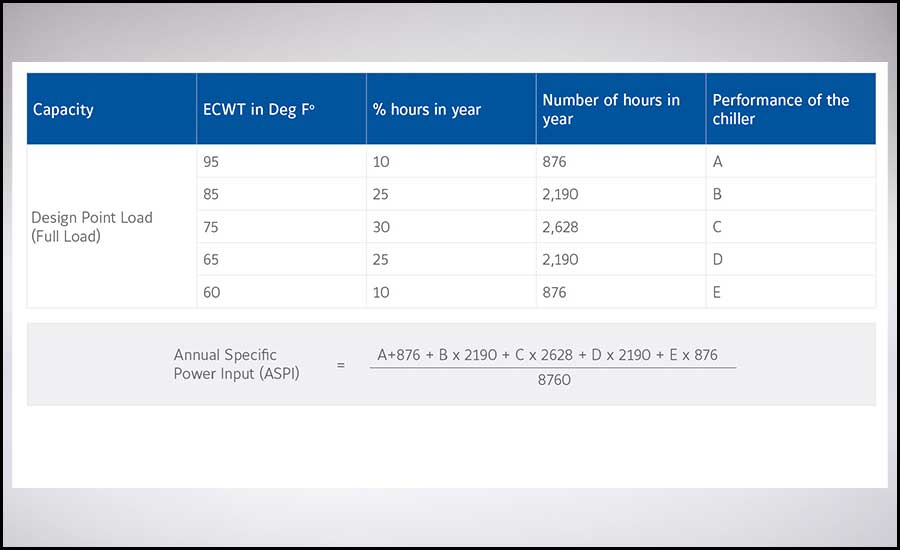
At the design point, the peak kW per ton for a chiller using a VSD is higher than that of a chiller using a CSD. This is because of the electronic losses of the VSD. However, the kW per ton of a chiller using a VSD begins to decrease below 65°F (18.3°C), resulting in up to 26% greater energy efficiency. This improvement can even be seen at a constant full load of 2,500 TR when compared to a chiller using a CSD.
The ASPI of a chiller using a VSD is 0.479 kW per ton, which is approximately 11% lower than the 0.537 kW per ton of a chiller using a CSD, indicating a significant reduction in annual energy use.
Achieving Accurate, Real-World Results
Chillers that use a VSD are more energy efficient than chillers that use a CSD, even for applications in which a chiller operates at very high loads. Between the load and the ECWT, the ECWT has a greater impact on chiller efficiency. From an efficiency perspective, the variation in internal building load is minor compared to the variation in ECWT. As the lift can vary based on annual weather patterns, the VSD significantly improves chiller performance between 25% to 30% better than a CSD.
The performance benefits of VSDs are further proven by the analysis of a water-cooled centrifugal chiller during a continuous full-load operation. When equipped with a CSD, the chiller sees improvement of only 2% or 3% on the design point. When using a VSD, the improvement is 11%. For a 2,500-TR centrifugal chiller running continuously on a full load throughout the year, this translates to an annual energy savings of 1,257,498 kWh and $150,900 in cost savings.
Reaching ambitious goals that have never been met before often requires new thinking, strategies, and technologies. For organizations to achieve net-zero commitments, it’s critical that equipment designers, owners, and operators understand how their systems consume power and what strategies they can implement to optimize energy consumption. In the case of chiller plants, this means understanding how chillers consume power, particularly at high loads, establishing accurate metrics that illustrate the most effective wasy to optimize the efficiency of chilled water systems, and integrating proven technology that achieves real-world results.



